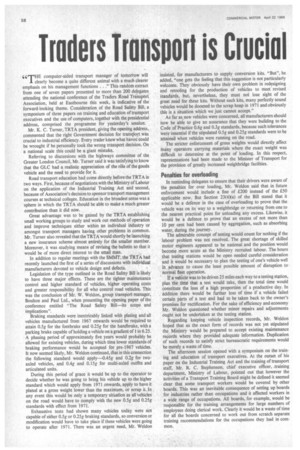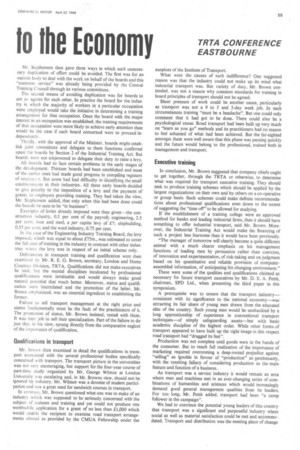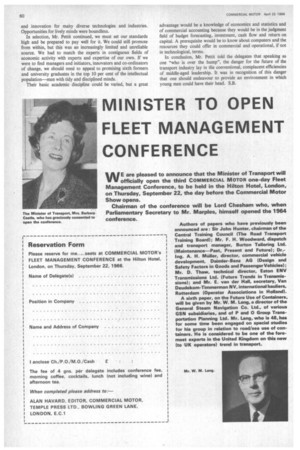Traders Transport is Crucial to the Economy
Page 60

Page 61

Page 62

If you've noticed an error in this article please click here to report it so we can fix it.
TRTA CONFERENCE EASTBOURNE
W'TIHE computer-aided transport manager of tomorrow will 1. clearly become a quite different animal with a much clearer emphasis on his management functions . . ." This random extract from one of seven papers presented to more than 200 delegates attending the national conference of the Traders Road Transport Association, held at Eastbourne this week, is indicative of the forward-looking theme. Consideration of the Road Safety Bill, a symposium of three papers on training and education of transport executives and the use of computers, together with the presidential address, comprised the programme for yesterday's session.
Mr. K. C. Turner, TRTA president, giving the opening address, commented that the right Government decision for transPort was crucial to industrial efficiency. Every trader knew what havoc could be wrought if he personally took the wrong transport decision. On a national scale this could be a giant mistake.
Referring to discussions with the highways committee of the Greater London Council, Mr. Turner said it was Satisfying to know that the GLC had a realistic appreciation of the rile of the goods vehicle and the need to provide for it.
Road transport education had come directly before the TRTA in two ways. First, because of negotiations with the Ministry of Labour on the application of the Industrial Training Act and second, because of Association's decision to sponsor transport management courses at technical colleges. Education in the broadest sense was a sphere in which the TRTA should be able to make a much greater contribution than it did now.
Great advantage was to be gained by the TRTA establishing small working groups to study and work out methods of operation and improve techniques either within an individual industry or amongst transport managers having other problems in common. Mr. Turner also revealed that the TRTA would shortly be launching a new insurance scheme almost entirely for the smaller member. Moreover, it was studying means of revising the bulletin so that it would be of more direct interest to the small man.
In addition to regular meetings with the SMMT; the TRTA had recently launched the first of a series of discussions with individual manufacturers devoted to vehicle design and defects.
Legislation of the type outlined in the Road Safety Bill is likely to have three major effects. These are the tighter maintenance control and higher standard of vehicles, higher operating costs and greater responsibility for all who control road vehicles. This was the conclusion of Mr. W. Weldon, group transport manager, Boulton and Paul Ltd., when presenting the opening paper of the conference entitled "The Road Safety Bill—its scope and implications".
Braking standards were inextricably linked with plating and all vehicles manufactured from 1967 onwards would be required to attain 0.5g for the footbrake and 0.25g for the handbrake, with a parking brake capable of holding a vehicle on a gradient of 1 in 6.25. A phasing period of approximately five years would probably be allowed for existing vehicles, during which time lower standards of braking performance would be accepted for pre-1067 vehicles. It now seemed likely, Mr. Weldon continued, that in this connection the following standard would apply-0.45g and 0.2g for twoaxled vehicles, and 0.4g and 0.15g for multi-axled outfits and articulated units.
During this period of grace it would be up to the operator to decide whether he was going to bring his vehicle up to the higher standard which would apply from 1971 onwards, apply to have it plated at a gross weight lower than the maximum, or scrap it. In any event this would be only a temporary situation as all vehicles on the road would have to comply with the new 0.5g and 0.25g standards with effect from 1971.
Exhaustive tests had shown many vehicles today were not capable of either 0.5g or 0.25g braking standards, so conversion or modification would have to take place if these vehicles were going to operate after 1971. There was an urgent need, Mr. Weldon insisted, for manufacturers to supply conversion kits. "But", he added, "one gets the feeling that this suggestion is not particularly welcome. They obviously have their own problem in redesigning and retooling for the production of vehicles to meet revised standards, but, nevertheless, they must not lose sight of the great need for these kits. Without such kits, many perfectly sound vehicles would be doomed to the scrap heap in 1971 and obviously this is a situation which we just cannot accept."
As far as new vehicles were concerned, all manufacturers should now be able to give an assurance that they were building to the Code of Practice 0.6g and 0.3g standards, because such tolerances were 'essential if the stipulated 0.5g and 0.25g standards were to be attained when vehicles were running on the road,
The stricter enforcement of gross weights would directly. affect Many operators carrying materials where the exact weight was difficult to determine at the point of loading. In this respect, representations had been made to the Minister of Transport for the provision of greatly increased weighbridge facilities.
Penalties for overloading
In reminding delegates to ensure that their drivers were aware of the penalties for over loading, Mr. Weldon said that in future enforcement would include a fine of £200 instead of the £50 applicable now. But Section 23(4Xa) of the Bill stated that it would be a defence in the case of overloading to prove that the vehicle was on its way to a weighbridge or returning from one to the nearest practical point for unloading any excess. Likewise, it would be a defence to prove that an excess of not more than 10 per cent had been caused by aggregation, such as absorbing water, during the journey.
The admirable concept of testing would count for nothing if the labour problem was not resolved. The great shortage of skilled motor engineers appeared to be national and the position would become more acute as the Ministry recruited labour. The hours that testing stations would be open needed careful consideration and it would be necessary to plan the testing of one's vehicle well in advance to cause the least possible amount of disruption to normal fleet operation.
If a vehicle was to be driven 25 miles each way to a testing station, plus the ,dmt that a test would take, then the total time would constitute the loss of a high proportion of a productive day. In addition there would be further loss of time if a vehicle failed certain parts of a .test and had to be taken back to the owner's premises for rectification. For the sake of efficiency and economy Mr. Weldon questioned whether minor repairs and adjustments ought not be undertaken at the testing station.
Regarding keeping vehicle inspection records, Mr. Weldon hoped that as the exact form of records was not yet stipulated the Ministry would be prepared to accept existing maintenance records where they provided adequate information. Duplication or such records to satisfy strict bureaucratic requirements would be merely a waste of time.
The afternoon session opened with a symposium on the training and education of transport executives. At the outset of his paper on the Industrial Training Act and the training of transport staff, Mr. R. C. Stephenson, chief executive officer, training department, Ministry of Labour, pointed out that however the activities of a Transport Training Board might be defined it seemed clear that some transport workers would be covered by other boards. This was an inevitable consequence of setting up boards for industries rather than occupations and it affected workers in a wide range of occupations. All boards, for example, would be responsible for the training arrangements for large numbers of employees doing clerical work. Clearly it would be a waste of time for all the boards concerned to work out from scratch separate training recommendations for the occupations they had in common. Mr. Stephenson then gave three ways in which such unnecessary duplication of effort could be avoided. The first was for an outside body to deal with the work on behalf of the boards and this "common service" was already being provided by the Central Training Council through its various committees.
The second means of avoiding duplication was for boards to act as agents for each other. In practice the board for the industry in which the majority of workers in a particular occupation were employed would take the initiative in determining a training arrangement for that occupation. Once the board with the major interest in an occupation was established, the training requirements of that occupation were more likely to achieve early attention than would be the case if each board concerned were to proceed independently.
Thirdly. with the approval of the Minister, boards might establish joint committees and delegate to them functions conferred upon the boards by Section 2 of the Industrial Training Act. But boards were not empowered to delegate their duty to raise a levy.
All boards had to face certain problems in the early stages of the development. Thirteen boards had been established and most of the earlier ones had made good progress in compiling registers of employers. But some had had difficulty in identifying the small estabestutients in their industries. All these early boards decided to give priority to the imposition of a levy and the payment of grants to employers providing training. They had taken the view, Mr. Stephenson added, that only when this had been done could the boards be seen to be "in business".
Examples of levies already imposed were then given—the construction industry, 0.5 per cent of the payroll; engineering, 2.5 per cent; iron and steel, a per capita levy of £7; shipbuilding. 0.55 per cent; and the wool industry, 0.75 per cent.
In the case of the Engineering Industry Training Board, the levy imposed, which was equal to about £75m., was estimated to cover the full cost of training in the industry in contrast with other industries where the levy was in respect of an initial scheme only.
Deficiencies in transport training and qualification were then examined by Mr. R. E. G. Brown, secretary, London and Home Counties Division, TRTA. Qualifications did not make executives he said, but the mental disciplines inculcated by professional qualifications were invaluable and would always make good natural potential that much better. Moreover, status and qualification were interrelated and the promotion of the latter, Mr. Brown emphasized, was an essential ingredient in establishing the former.
Failure to sell transport management at the right price and status fundamentally must be the fault of the practitioners of it. The promotion of status, Mr. Brown insisted, rested with them. It was their job to sell their specialization. Part of the failure to do just this, in his view, sprang directly from the comparative neglect of the importance of qualification.
Qualifications in transport
Mr. Brown then examined in detail the qualifications in transport associated with the several professional bodies specifically concerned with transport. The transport picture in the universities was not very encouraging, but support for the four-year course of part-time study organized by Mr. George Wilmot at London University was escalating and, in Mr. Browns view, should not be ignored by industry. Mr. Wilmot was a devotee of student participation and saw a great need for sandwich courses in transport.
In contrast, Mr. Brown questioned what one was to make of an industry which was supposed to be seriously concerned with the subject of trainees and training and yet could not produce one worthwhile application for a grant of no less than £1,000 which would enable the recipient to examine road transport arrangements abroad as provided by the CMUA Fellowship under the auspices of the Institute of Transport.
What were the causes of such indifference? One suggested reason was that the industry could not make up its mind what industrial transport was. But variety of duty, Mr. Brown contended, was not a reason why common standards for training in board principles of transport should not be agreed.
Sheer pressure of work could be another cause, particularly as transport was not a 9 to 5 and 5-day week job. In such circumstances training "must be a headache". But one could only comment that it had got to be done. There could also be a psychological cause. Road transport had been built up very much on "learn as you go" methods and its practitioners had no reason to feel ashamed of what had been achieved. But the far-sighted amongst them were well aware that this phase was passing quickly and the future would belong to the professional, trained both in management and transport.
Executive training
In conclusion, Mr. Brown suggested that company chiefs ought to get together, through the TRTA or otherwise, to determine what was required for transport executive training. They should seek to produce training schemes which should be applied by the largest organizations on their own and by others on a co-operative or group basis. Such schemes could make definite recommendations about professional qualifications even down to the extent of suggesting the "time-off" to be allowed for studying.
If the establishment of a training college were an approved method for banks and leading industrial firms, then it should have something to offer industrial transport, said Mr. Brown. Moreover, the Industrial Training Act would make the financing of such a project less fearsome than it would have been previously.
"The manager of tomorrow will clearly become a quite different animal with a much clearer emphasis on his management functions of leading men by persuasion rather than coercion, of innovation and experimentation, of risk-taking and on judgment based on his quantitative and reliable provision of computerassembled information, of anticipating his changing environment."
These were some of the qualities and qualifications claimed as necessary for future transport executives by Mr. D. E. A. Pettit, chairman, SPD Ltd., when presenting the third paper in this symposium.
A prerequisite was to ensure that the transport industry— consistent with its significance to the national economy—was attracting its fair share of young men drawn from the educated elite of the country. Such young men would be unshackled by a long apprenticeship of experience in conventional transport techniques—of simply safeguarding assets—but with basic academic discipline of the highest order. While other forms ,of transport appeared to have built up the right image in this respect road transport had "dragged its feet".
Production was not complete until goods were in the hands of the consumer. But to reach full realization of the importance of marketing required overcoming a deep-rooted prejudice against "selling" as ignoble in favour of "production" as gentlemanly, with the resulting fallacy of considering production as the main feature and function of a business.
As transport was a service industry it would remain an area where men and machines met in an ever-changing series of combinations of humanities and sciences which would increasingly demand good general management qualities from its leaders. For too long, Mr. Pettit added, transport had been "a camp follower in the campaign".
We had to convince the potential young leaders of this country that transport was a significant and purposeful industry where social as well as material satisfaction could be met and accommodated. Transport and distribution was the meeting place of change and innovation for many diverse technologies and industries. Opportunities for lively minds were boundless.
In selection, Mr. Pettit continued, we must set our standards high and be prepared to pay well for it. We could still promote from within, but this was an increasingly limited and unreliable source. We had to match the experts in contiguous fields of economic activity with experts and expertise of our own. If we were to find managers and initiators, innovators and co-ordinators of change, we should need to appeal to promising sixth formers and university graduates in the top 10 per cent of the intellectual population—men with tidy and disciplined minds.
Their basic academic discipline could be varied, but a great advantage would be a knowledge of economics and statistics and of commercial accounting because they would be in the judgment field of budget forecasting, investment, cash flow and return on capital. A prerequisite would be to know about computers and the resources they could offer in commercial and operational, if not in technological, terms.
In conclusion, Mr. Pettit told the delegates that speaking as one "who is over the hump", the danger for the future of the transport industry lay in the conventional, complacent efficiencies of middle-aged leadership. It was in recognition of this danger that one should endeavour to provide an environment in which young men could have their head. S.B.




























































































































